![]()
ARMAMENT BROADCAST AMPLIFIER
![]()
ARMAMENT BROADCAST AMPLIFIER
This standard, 50 watt amplifier, known as a "loud hailer" was used to page specific personnel. It was used specifically as an Armament Broadcast Amplifier. The cabinet for this amplifier (A/P 12522) is just forward of the Radio 1 door but the cabinet is empty. There are two mounting brackets with an inter connecting cable. At some point in time, the amp was removered from this enclosure and reinstalled without any enclosure in the Electronics Maintenance Room.
| The 50 watt Armament Broadcast amplifier can be found in the port passageway ahead of the door in Radio 1. The location of the microphone used for hailing is not known at this time. (Photo by Jerry Proc) |
| Nameplate for the Armament Broadcast Amplifier. .It was made by the Monitor Radio and Communications Company in Stechford, Birmingham, UK. (Photo by Jerry Proc) |
CLOCK
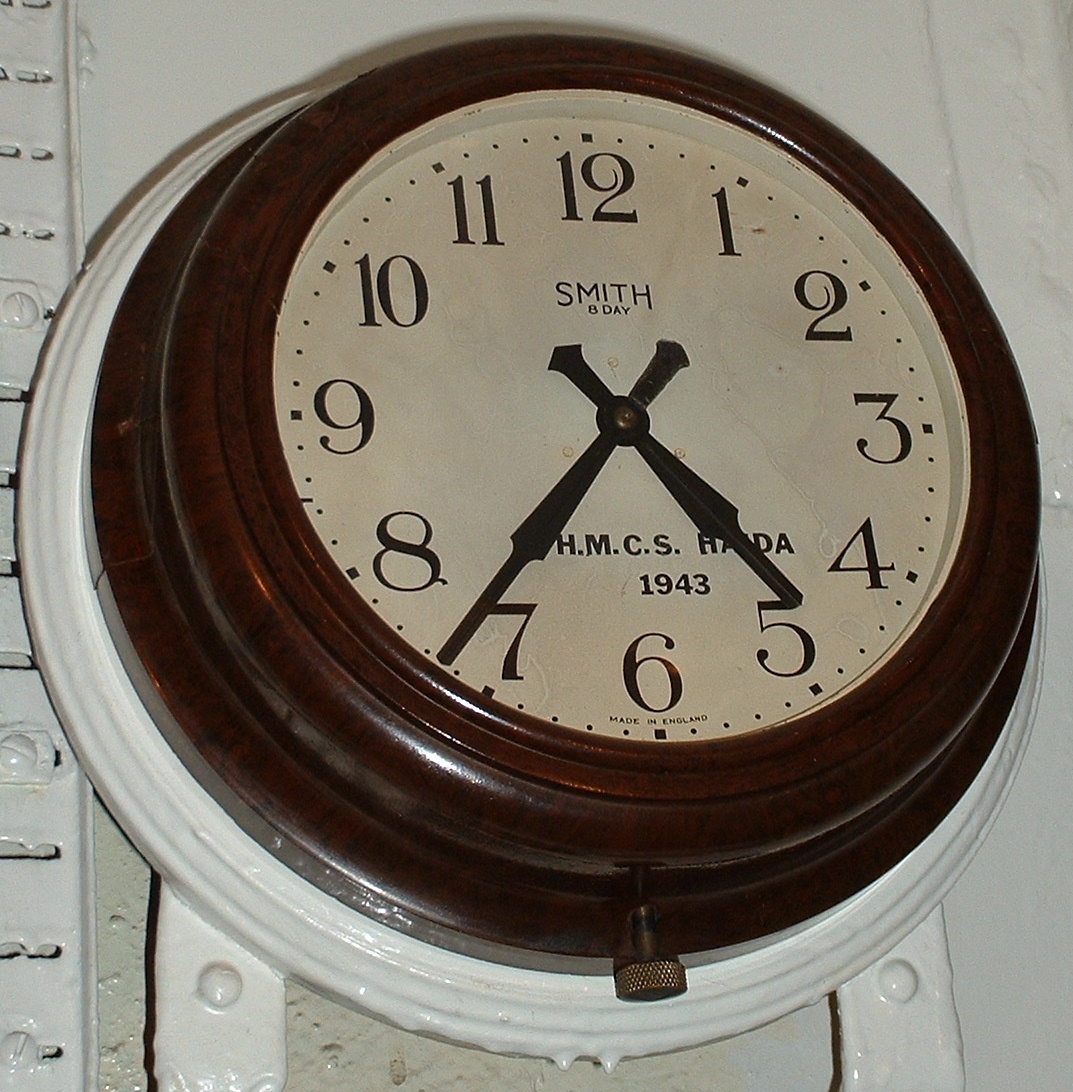 |
| This was an original clock , one of a few, installed into HAIDA on-build in 1943. The story of how the clock made it back to the ship can be found here. |
BELL
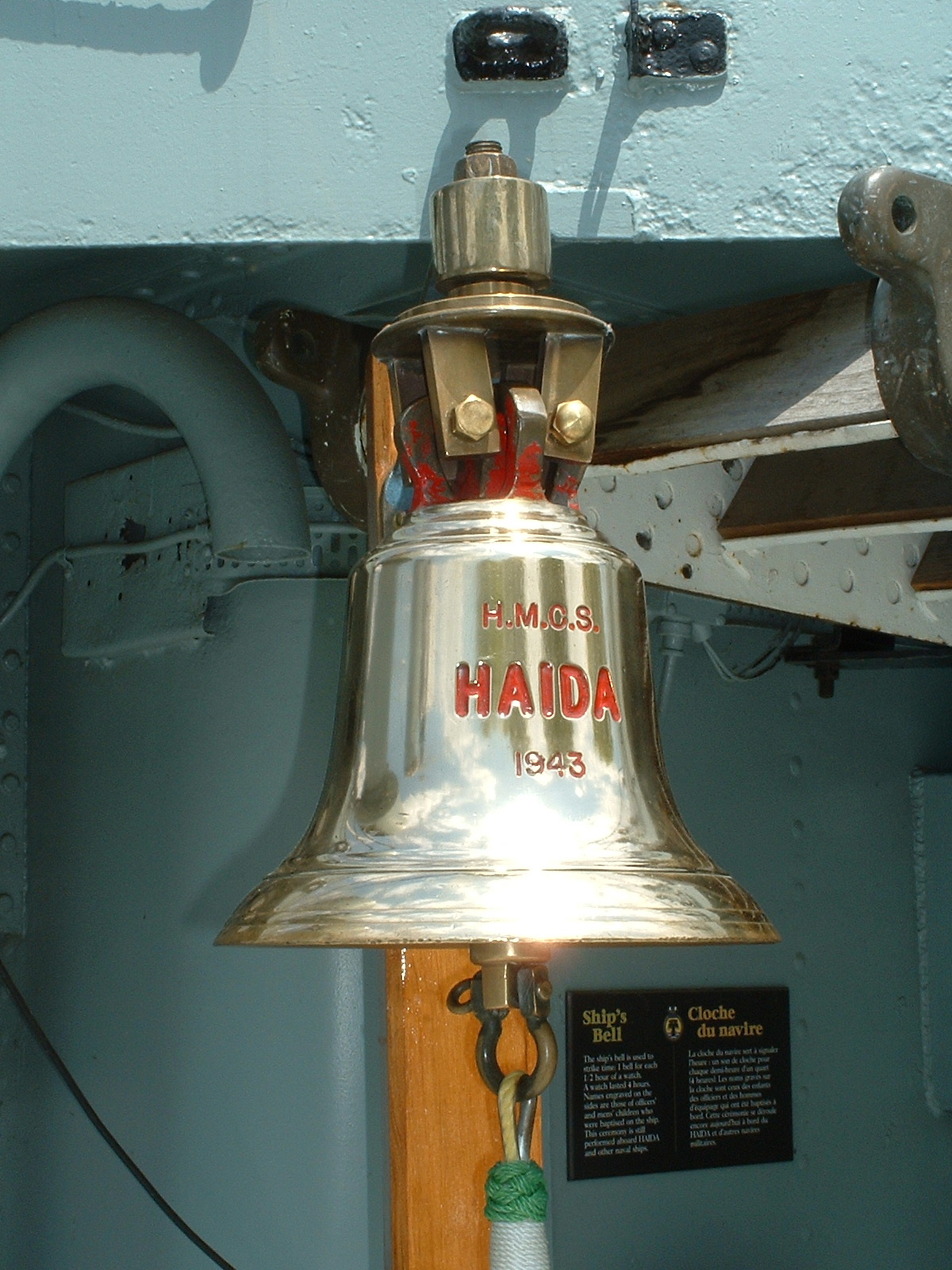 |
| Many offspring of navy ratings had the honour of being christened aboard ship when the opportunity presented itself. It is a Navy tradition that goes back to the days of sailing ships. The bell would be disconnected from its mounting, turned upside down and filled with holy water. The chaplain would then perform the baptism ceremony. Upon completion of the service, the blessed water was not just poured over the side of the ship. Instead , it was piped over the side, just like a Captain arriving or departing. |
BULLRING and FAIRLEAD
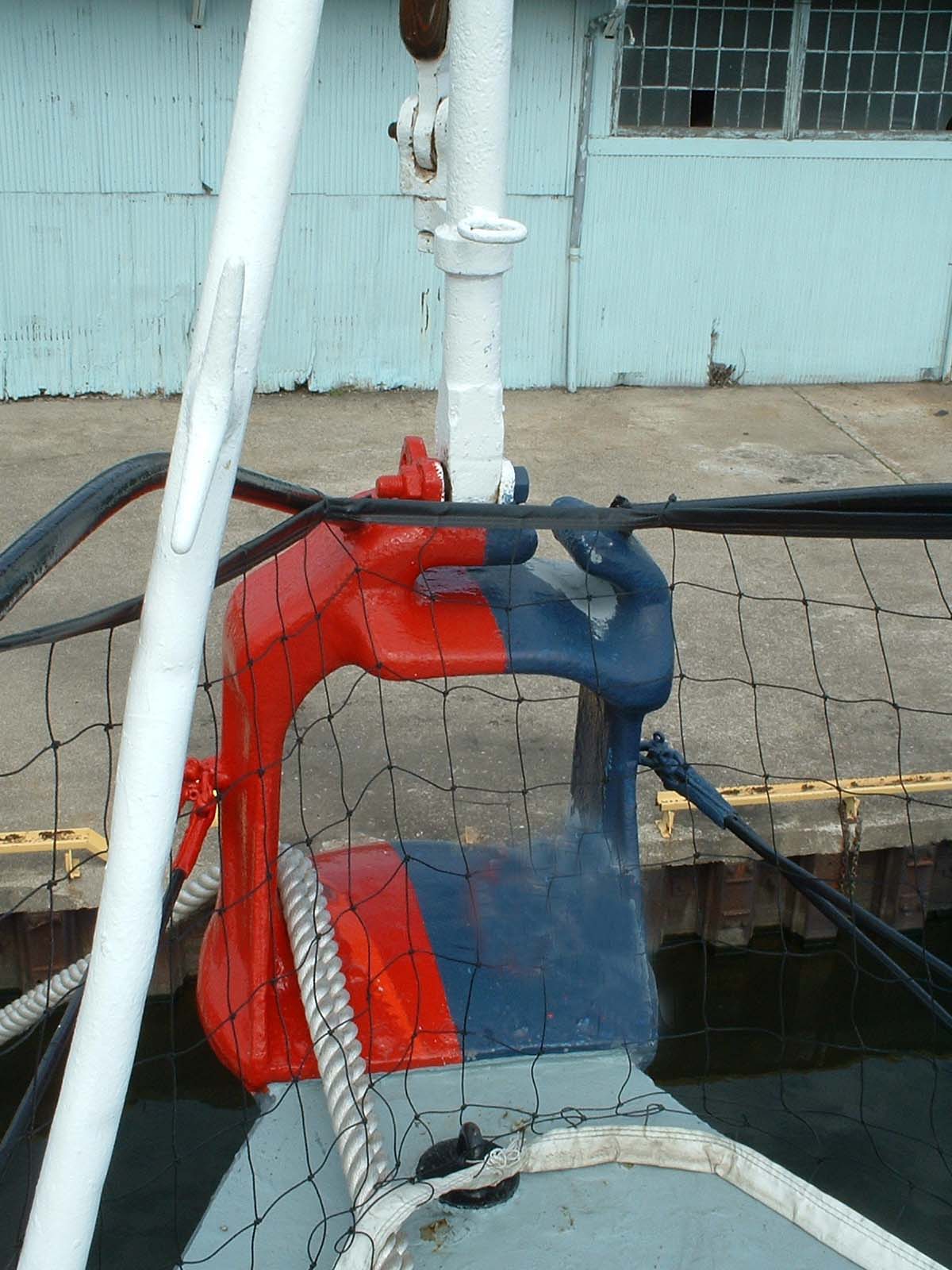 |
The bull ring (the large, square ring in the
bow)would be used for short distance towing.When towing a short distance,
the tow line would be connected to the anchor cable and they would let
out at least one shackle to help keep the tow line under water. For long
distance towing they would make up a bridle coming off either side
of the bow to the tow line to help keep it under control.
Why is the bullring painted red and blue? Traditionally, when a ship crosses the Equator or the Arctic Circle, the bullring is painted either red or blue for a while to mark the occasion. HAIDA crossed both during her service life . A recent Canadian innovation is painting the bullring green when a ship visits Churchill, Manitoba on Hudson Bay. The first Canadian ship to visit the Black Sea also painted her bullring blue since black is the normal colour. The painting is done by the youngest officer and non-commissioned member. (Photo by Jerry Proc) Atop the bullring is the Angle Fairlead. A fairlead is a device to guide a line, rope or cable around an object, out of the way or to stop it from moving laterally. Typically a fairlead will be a ring or hook. Some fairleads are called "roller fairleads" because they have rollers on either side and one on the top or bottom. The top one can be opened to get the line in or out. |
CATWALKS
CHARLIE NOBLE
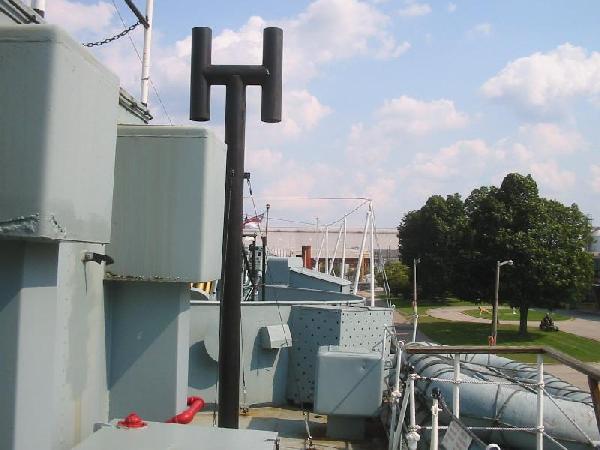 |
| The exhaust stack for the stove in the Officer's Galley was known as the "Charlie Noble" and was restored in 2006. Around 1850, a British merchant service captain, Charles Noble, upon discovering that the stack of his ship's galley was made of copper, ordered that it be kept bright. From then onwards, the ship's crew started referring to the galley smokestack as the "Charlie Noble". (Photo by Jim Brewer) |
COLOUR / PATTERN SCHEMES
HAIDA was painted in six colour schemes during her service life. The actual paint codes used are listed elsewhere on this web site. Ship modeller Darren Scannell offers some insight regarding colour schemes in general."In WWII, (and for a short time after) the RCN mainly used the RN Admiralty Standard colour system, especially for ships attached to UK ports and sailing under RN orders. However, there was a lot of work done by the National Research Council and the RCN to develop their own paint schemes and colours for convoy duty in the North Atlantic.
There are lots of stories and much speculation around paint and colours used during WWII by the RN, RCN, USN and pretty much every Navy around. For instance, I've heard about Canadian Ships dumping Canadian paint overboard enroute to the UK because it was considered inferior to UK paint. (it peeled off quickly or turned yellow). I've also read about substituting paint and colours when official supplies weren't available. There's also evidence of ship captains having the freedom to be creative when applying patterns and colours.
A large effort on both sides of the Atlantic went into trying to find colours and patterns that would help to confuse and distort a ship's silhouette when viewed at a distance. Another big issue was defining exactly what a colour looked like. During the war, colours changed, either because supplies were scarce, or variations were determined to be more effective. However, the number designation might not change. For instance G20 had a green tint later in the war, as opposed to a neutral grey mid war. If a ship is supposed to have G20 applied in June 1944, and the colour was officially changed in May 1944, (example dates) when did it did it actually get the new colour? It takes time to use up old paint stocks, propagate the orders and produce and supply new stocks. It might be September before the new colour starts appearing. Or it might not. The tints and dyes might already exist in naval stores. Then there is the issue of mixing. How close will a sailor get to the specified colour each time he mixes a batch of paint?Most of the paint supplied during WWII would have to be mixed at the shipyard or on board ship. There were commercial pre mixed supplies available, but not in great quantities".
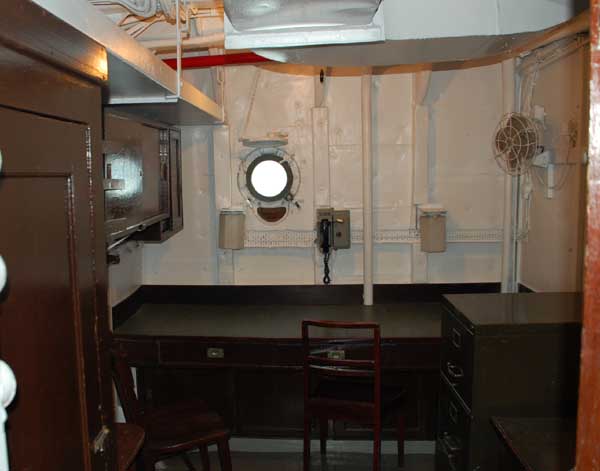 |
| Coxswain's (Regulating) Office: As the senior non-commissioned officer, the Coxswain worked closely with the Captain on the administration of the ship and crew. Mail was also sorted and sent from this office. |
DEADLIGHT
 |
| A deadlight is a cover for a scuttle (porthole). It is a heavy hinged metallic plate that can be secured over a scuttle. It prevents water ingress should the glass be damaged. It is especially important that the deadlight be secured if engaging with the enemy. |
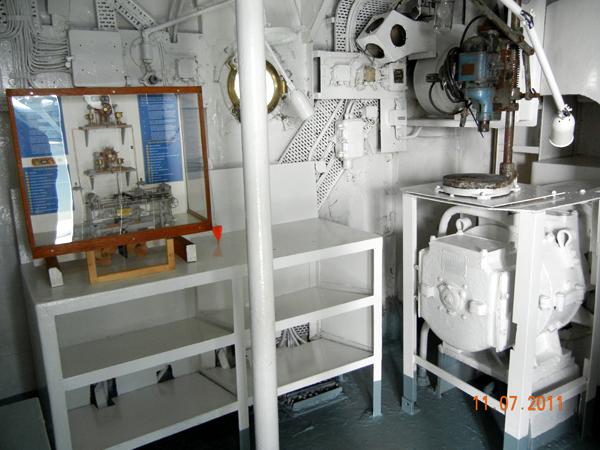 |
| The Engineering Workshop was repainted by HAIDA's volunteer Stoker, Marg Mathers in 2011. At the left side is a model to illustrate the operation of the tiller motor, associated hydraulics and controls. It was built by Marg Mathers and Jim Brewer. (Photo by Jim Brewer) |
ESCAPE SYSTEM - Firefighting and Flooding
In the event of a fire, there was a 40 ton per hour steam turbine, fire and bilge pump in the gearing room. In addition, there was a 20 ton per hour electrically operated pump. Fire pumps were also located in the aft lower mess deck and wardroom flats which fed the fire-main running throughout the ship using with hydrants, hoses, nozzles, extinguishers which were both modern and original . Also included were breathing apparatus (Chemox) in all compartments. Everyone was trained in firefighting.How did the ship deal with flooding? There was a 40 ton/hour steam turbine fire and bilge pump in the gearing room and 20 ton/hour electrical hull and fire pumps in the aft lower mess deck and wardroom flats. Each of the five engineering spaces had two steam driven bilge ejectors and there was also a 50 ton/hour General Service Pump in #3 Boiler Room (moved from the Engine Room in 1957 when the 25 ton/hour evaporator was installed) to pump out the engineering spaces. There was a 70 ton/hour electrical salvage pump stored forward of the galley in the cross passage. The original British Tribal class had a mechanical Downtown pump on the upper deck operated by manpower.
So what do the letters on doors and hatches mean? They are watertight control markings. Normally Z openings can be left open, Y openings can be opened to pass through while X openings are not to opened without permission.
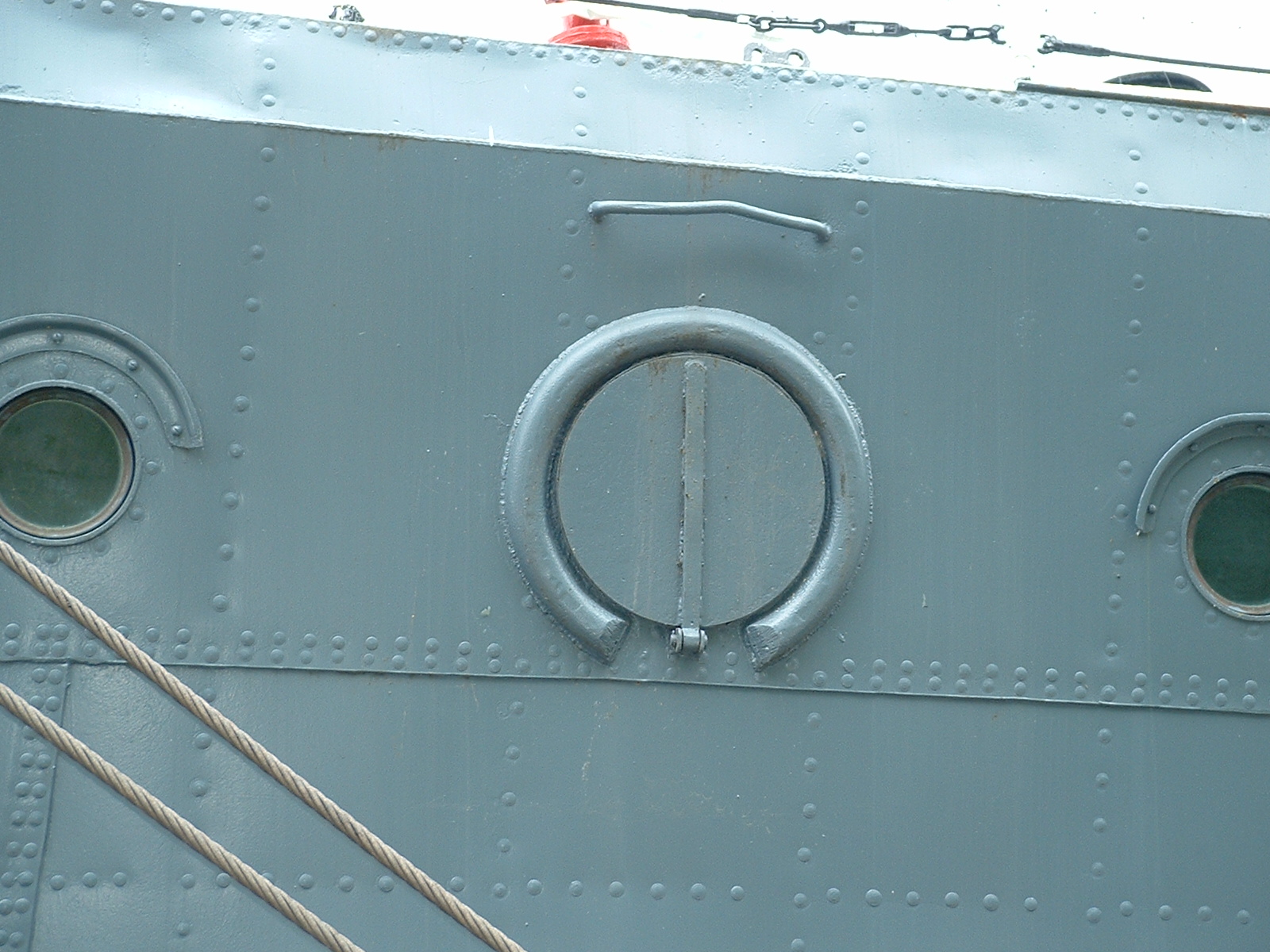 |
| In case of fire or flooding, the forward upper messdeck had
four escape scuttles which were 15.75 inches diameter. Two were on
the port side and two on the starboard side. All mess decks
had an 17” diameter escape hatch to the deck above or to the escape
scuttle. It paid to be skinny!
(Photo by Jerry Proc)
There are two escape hatches in the the mess decks from the lower to the upper. The main hatches could be used ,but if there was flooding in the lower mess then they used the escape hatches because the main hatches would be sealed . It is easier to control flooding with the small hatches. |
| This is one of the escape hatches as seen from the upper Mess deck. |
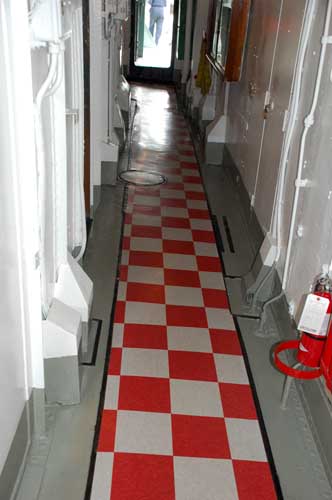 |
| In the forward port and starboard passageways, the existing 12" x 12" tiles were removed and replaced with period (Korean war era) 9"x 9" tiles. Since this format of tile is no longer available, 12" x 12" tiles were purchased and then pruned from 12"x 12 " to 9"x 9" size at the shop of the tile layer. The same colour pattern was used in the forward mess areas and the passageways were also repainted. The aft passageway also received the same treatment but a green/gray pattern was used. |
PLATE
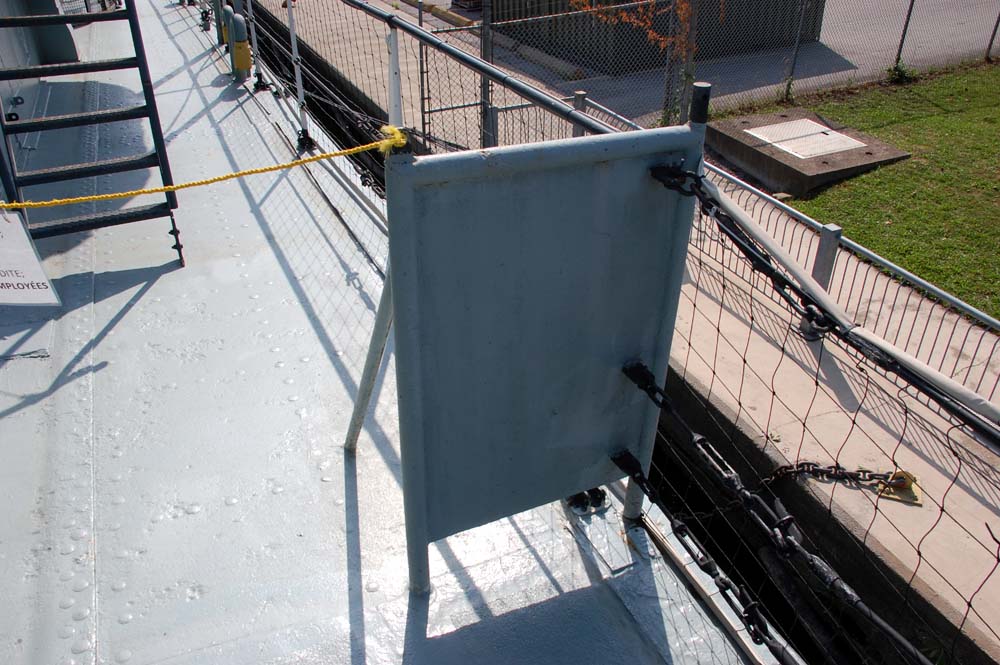 |
| On HAIDA's port side, just slightly aft of the brow is a plate.
There is an identical plate in the sane spot but on the starboard side.
On the outboard side of the plate, at the top, there is a post on which
something could be mounted. At the top but on the inboard side, there is
lug with a hole in it, a possible tie-down point for something.
Does anyone know the purpose of this plate? If so , contact Jerry Proc jerry.proc@sympatico.ca (Photo by Jerry Proc) . |
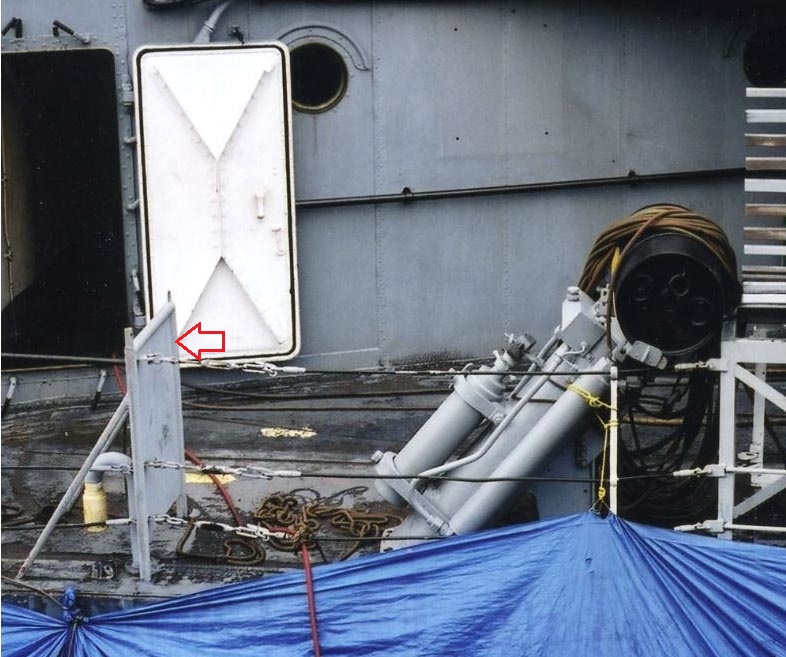 |
| This is the view of the plate on the starboard side. Aft is to the left. The fubction that it served could be used from either side of the shop. (Photo by Darren Scannell) . |
SECURITY
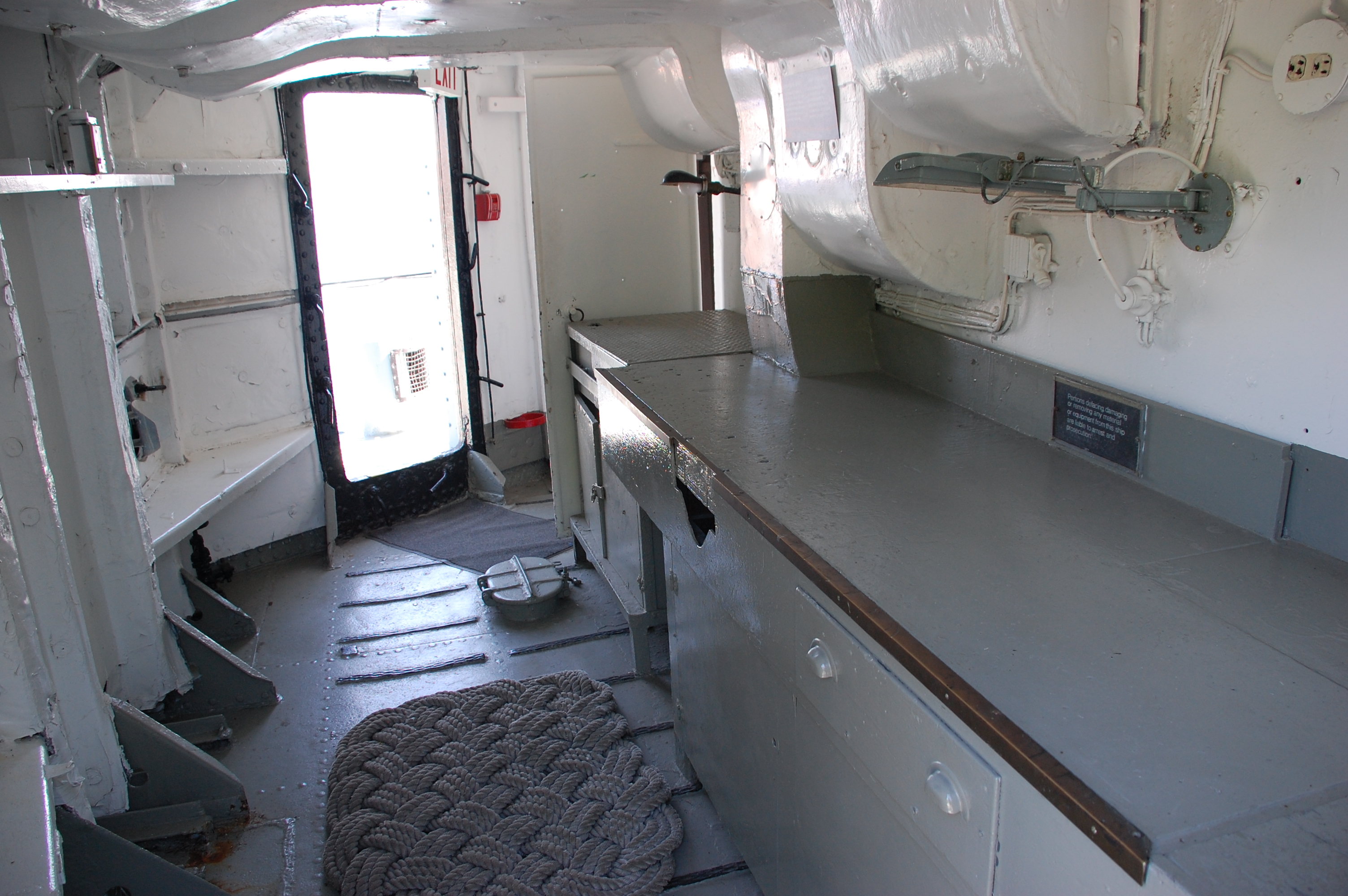 |
| The Shipwright's shop is located directly aft of 'A" gun. Here, the Shipwright kept all the tools and materials that he needed to carry out his trade. The rope rug in the foreground was not part of that compartment. It was woven by the daughter of Jim Brewer and her friend, in effort to demonstrate one of the skills of a Quartermaster. The rug took approximately four weeks to weave. (Photo by Jerry Proc) |
SHIP'S SIRENETTE
The ship's sirenette would have been used in foggy conditions or to let other ships know what maneuver was going to be executed by own ship.There was a code for doing this:1 short blast for going to starboard
2 short blasts for going to port
3 short blasts for going astern
1 long blast for getting under way
WATER MANAGEMENTand WASH BASINS
How much fresh water did HAIDA carry? Not enough, since the priority was boiler feed water, cooking and people in that order. There were approximately 46 tons (tanks at 95% toallow for expansion) or 10,316 gallons (1 ton = 36 cubic feet or 224 gallons, 1 cubic foot = 6.23gallons) stored in five tanks (3 forward and 2 in #2 boiler room) with a pressure pump in the fwd lower mess deck and expansion tanks outside the Chief’s Mess and Sick Bay.How much boiler feed water was there? Almost 50 tons or over 11,000 gallons. (1 ton of water = 224 Imp gallons) in tanks in the engine room and #2 boiler room. The system used several tons of feedwater daily as steam was used to periodically blow soot of the boiler tubes, to blow down the boilers to reduce the concentration of impurities in the feed water, and to sound the sirenette.
What if they ran out of water? There are two evaporators in the engine room, a 19 ton unit to port and a more modern 25 ton vacuum unit to starboard, which produce distilled water from sea water. The evaporators built up scale and deposits and had to be cleaned daily.
 |
| Wash basin area and shower stall off the port side passageway,
mid-ship. Water for washing was drawn from the fresh water tanks then replenished
from the evaporator when HAIDA was at sea. At the aft end, there were two
showerheads which are covered by the poster. (Photo by Jerry Proc)
It should be noted that crew did not take a shower while at sea or on station as fresh water was in limited supply. Instead, to conserve water, the crew took what they called a “bird bath” using the sink. You simply soaped the desired parts of your body, then scooped the water over the area to remove the soap. This of course made for a watery mess on the deck. Each messdeck was assigned to mop out the washroom on a daily scheduled basis. When theTribals built in the UK went into service, one small feature was a ceramic sink in the Officers quarters. Everything was fine until the ship started to drop depth charges. As a result, all the sinks developed cracks so they had to be replaced with a stainless steel type. On HAIDA , there were four, single heads which adjoined
the starboard passageway, mid ships. One was for Officers, one for
Chief Petty Officers and two for Petty Officers. The two aft
heads, across from the Captain's Day cabin were for use by Officers only.
On-build, HAIDA had a sink and a bath tub for the Officers. These items were located aft of the Captain's Day cabin. Whne HAIDA became a museun ship in Toronto, the washing facilty was rebuilt with a shower and a hot water tank. These items were removed in 2002 and replaced with the original sink and bath tub. |
| This is the forward fresh water pump. It draws fresh water from the three tanks then sends it to the two expansion tanks. (Photo by Jerry Proc) |
Credits:1) Jim Brewer
2) Neil Bell - HAIDA FAQ
3) https://www.submerged.co.uk/kelvins-machine/
4) Koji Kamori
5) https://collections.rmg.co.uk/collections/objects/42900.html
6) Kelvite Mk4 http://www.godfreydykes.info/KELVITE%20SOUNDING%20MACHINE%20-%20PART%201.pdf
7) Peter Dixon
8) Clive Kidd
June 12/23